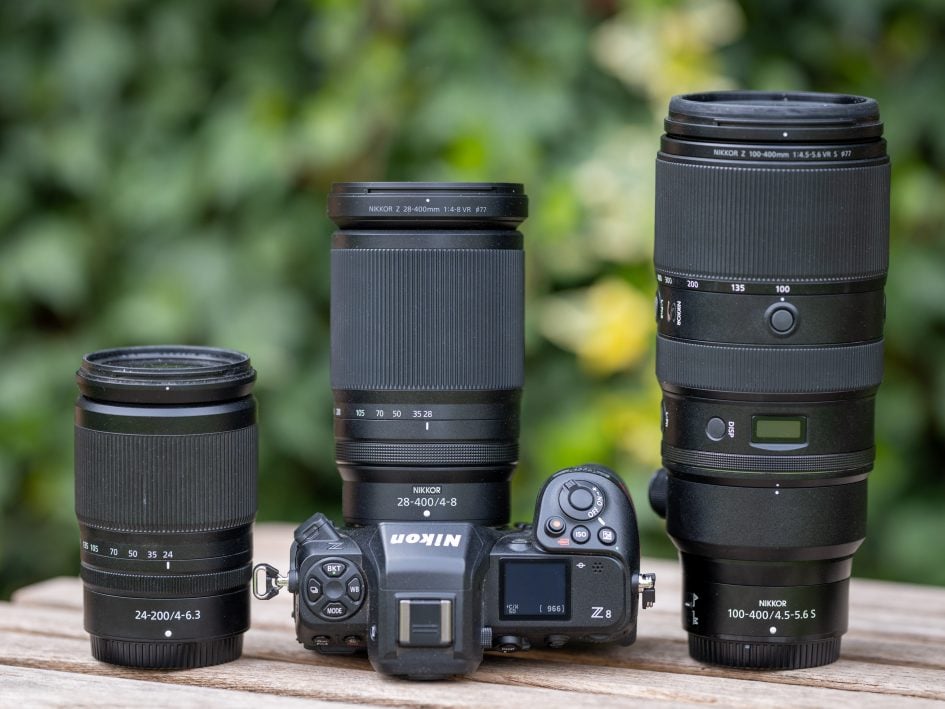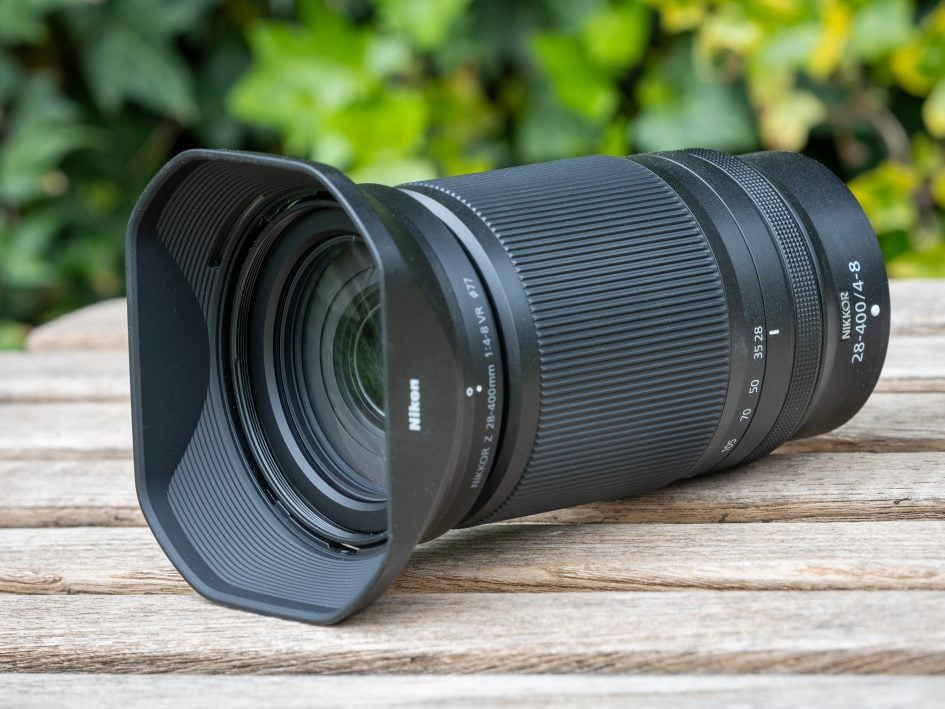Nikon Z 28-400mm f4-8 VR review
-
-
Written by Thomas
Verdict
As Nikon’s zoom lens with the widest 14.3x zoom range to date the Z 28-400mm f4-8 VR adds a nice alternative to their Z 24-200mm f4-6.3 VR for all those who want 100% more reach with a lens that is neither too large nor too heavy or expensive. Optically the Z 28-400mm f4-8 VR turned out to be a good performer: Sharp in the center, fast and reliable autofocus, with colour aberrations, coma, focus-breathing, and distortions very well controlled. And it shows very good resistance against flare, (veiling) glare, and ghosting, letting you shoot confidently under adverse contra-light situations. Add to that the optical image stabilization and full weather sealing. All that at only 0.76kg and a reasonable price of 1549 EUR / 1297 USD / 1399 GBP makes the Z 28-400mm f4-8 VR an interesting second super-zoom in Nikon’s line-up of Z-Nikkors.
What’s not to like – apart from the flimsy lens pouch? Well, I had hoped the lens were sharper outside the center and at close-ups. And that optical image stabilization were closer to Nikon’s claim of 5.5 stops. Then there is the issue of the wide end starting at 28mm (not 24mm) plus the lowly focal ratio of f8.0 from 190mm onwards which also leads to a meagre Bokeh. And I have other smaller gripes: The lens is not parfocal and has no fluorine coating at the front. Btw, if you’re bothered about 28mm focal length being too long consider covering the (ultra-)wide end with Nikon’s Z 14-30mm f4 S.
Let’s put this into perspective and have a closer look at how the Nikon Z 28-400mm f4-8 VR compares to some alternatives.
Above from left to right: Nikon Z 24-200mm f4-6.3 VR, Z 28-400mm f4-8 VR, Nikon Z 100-400mm f4.5-5.6 VR S
Compared to Nikon Z 24-200mm f4-6.3 VR
The Z 24-200mm f4.0-6.3 VR was Nikon’s first super-zoom for Z-mount. In comparison to the new Z 28-400mm it has several advantages: It is smaller, lighter, cheaper, has a 2/3 of a stop larger focal ratio at the long end, and goes 4mm wider at the short end which results in a 9 degrees wider angle-of-view. And it is sharper than the Z 28-400mm (except on the short end). It’s biggest downside? The missing 200mm at the long end leaving you with only 11MP should you crop into a 45MP image to achieve the same angle-of-view as a 400mm shot. Which might still be sufficient for the intended purpose e.g. viewing in 4k resolution. But other than that: Nikon’ first super-zoom is a compelling alternative to their new Z 28-400mm f4-8 VR!
For more details see my Nikon Z 24-200mm f4-6.3 VR review where the lens came Recommended.
Compared to Nikon Z 24-70mm f4 S + Tamron 70-300mm f4.5-6.3 Di III
Any two lens combo has a clear disadvantage over a single super-zoom: You need to swap lenses when the intended angle-of-view for the scene you’re shooting is not in the range of the lens you’ve currently mounted. That may not be critical if you need a narrower view as you can always crop. But if you need a wider view and cannot step back you lose valuable time changing to the shorter zoom lens. This might cost you the shot. That said it is interesting to note that both combos in this and the following comparison (and the Z 24-200mm) start at 24mm at the short end. This might actually be a valuable benefit for you especially in close quarters or wide land-/cityscapes: It let’s you capture more of the scene with a 9 degrees wider angle-of-view.
The combination of Nikon Z 24-70mm f4 S and Tamron 70-300mm f4.5-6.3 Di III naturally is bigger and heavier than the Z 28-400mm but not overly so. And it is (perhaps surprisingly) cheaper than the super-zoom – if you can get a Z 24-70mm at a discount. Optically the combo is sharper than the Z 28-400mm and also retains a 2/3 to 1 stop brighter focal ratio once you zoom in beyond 40mm. Maximum magnification is 1:3.1 (on the Z 24-70mm) with much better image quality than from the Z 28-400mm. What are the biggest disadvantages of the combo – apart from the need to swap lenses? The missing optical image stabilization makes the Tamron 70-300mm not the best choice for Nikon’s non-stabilized cropped sensor cameras. But with the built-in stabilization of Nikon’s full-frame cameras stabilization of the Tamron at 300mm was at least as good as from the Z 28-400mm at 400mm. And then there is the missing 100mm at the long end: But the Tamron 70-300mm is so sharp at 300mm that you can easily crop 1.33x to an angle-of-view of 400mm focal length and still get satisfyingly detailed images.
So, this combo is a viable alternative to the Z 28-400mm f4-8 VR – if you don’t mind swapping lenses at the 70mm point.
For more details see my Nikon Z 24-70mm f4 S review (Highly Recommended) or my Tamron 70-300mm f4.5-6.3 Di III review (Recommended).
Compared to Nikon Z 24-120mm f4 S + Z 100-400mm f4.5-5.6 VR S
This two lens combo has the benefit of shifting the point where you need to swap lenses to focal lengths of 100-120mm. I personally find this less irritating than having to change lenses at or around 70mm. Both the Z 24-120mm and Z 100-400mm deliver the best optical performance of the lenses compared here and they cover the widest zoom-range of 16.7x – albeit with two lenses. They also retain a 1-1.5 stops brighter focal ratio once you zoom in beyond 50mm. And the optical image stabilization of over 5 stops proves helpful with the challenges of hand-holding a lens at 400mm. But this combo is almost 3 times as heavy, 2 times more expensive, and needs much more space in your bag than the Z 28-400mm f4-8 VR. So choices are clear: If you need compact and light and have a limited budget you better consider getting one of Nikon’s super-zooms.
For more details see my Nikon Z 24-120mm f4 S review or my Nikon Z 100-400mm f4.5-5.6 VR S review where both lenses came Highly Recommended.
Nikon Z 28-400mm f4-8 VR final verdict
The Z 28-400mm f4-8 VR offers an enormous 14.3x zoom range in a pretty compact and lightweight package. Its optical image stabilization helps compensate for the lowly focal ratio of f8.0 at the long end and supports handheld shooting even at 400mm focal length. It certainly is one of the softer lenses in Nikon’s Z line-up but if you refrain from pixel-peeping and normally prefer viewing at 4k resolution you will not be disappointed. And although not exactly cheap the lens still offers a good price/performance ratio. If you want to cover the wide end and reach 400mm focal length in one lens the Z 28-400mm f4-8 VR is without alternative: Recommended – especially for those who want to travel light and not change lenses in the middle of things!
Good points:
- Compact and lightweight for a zoom lens reaching 400mm.
- Good optical image stabilization – although well below Nikon’s claimed 5.5 stops.
- Pretty fast and reliable AF operation and very low focus breathing.
- Very good resistance against flare, (veiling) glare, and ghosting.
- Practically no longitudinal colour aberrations or purple fringing.
- Very little vignetting at the long end and no distortions – through lens-profile.
- Weather sealing, multi function ring, zoom lock.
- Good price/performance ratio.
Bad points:
- Wide end starts at 28mm focal length, not 24mm.
- Performance outside the center relatively soft (except at 28mm).
- For close-up shots better use at 400mm focal length stopped down to f11.
- Lowly focal ratio of f8.0 from 190mm onwards.
- Meagre Bokeh.
- Lens is not parfocal.
- No fluorine coating at the front.






